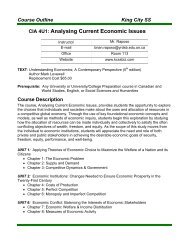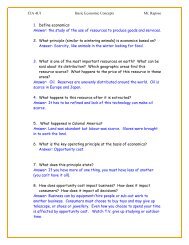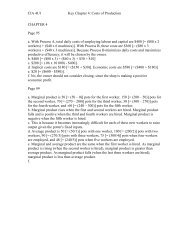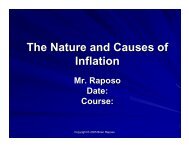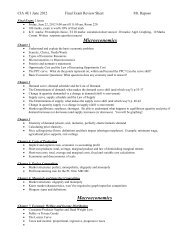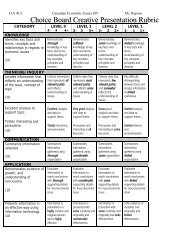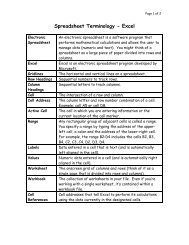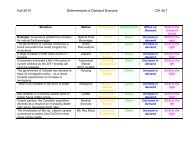Chapter 8: Measures of Economic Activity
Chapter 8: Measures of Economic Activity
Chapter 8: Measures of Economic Activity
Create successful ePaper yourself
Turn your PDF publications into a flip-book with our unique Google optimized e-Paper software.
An Introduction to<br />
Macroeconomics<br />
Date: Fall 2009<br />
Course: CIA 4U1<br />
Mr. Raposo
The Business Cycle<br />
• Refers to the general “ups and downs” in<br />
economic activity over a period <strong>of</strong> time<br />
• Typically characterized by 4 phases
Recovery<br />
The Business Cycle<br />
The Business Cycle<br />
Trough<br />
Peak<br />
Peak<br />
Recession Recession<br />
Recession Recession<br />
Recovery<br />
Trough<br />
Time<br />
Business Level <strong>of</strong> <strong>Activity</strong>
4 Phases <strong>of</strong> the Business<br />
Cycle<br />
1. Peak<br />
2. Recession<br />
3. Trough<br />
4. Recovery
<strong>Economic</strong> Prosperity:<br />
The Demand Side<br />
• The total output <strong>of</strong> the economy (GDP)<br />
will depend on the level <strong>of</strong> total spending<br />
on goods and services in the economy<br />
(the demand side).<br />
• Aggregate Demand (AD): : Total<br />
spending on goods and services
Aggregate Demand<br />
• consists <strong>of</strong> consumption (C), investment<br />
spending (I), government spending (G) and<br />
net exports (X – M).<br />
• AD = C + I + G + ( X – M )<br />
• C = Consumption<br />
• I= Investment<br />
• G=Government Spending<br />
• Net Exports = exports (X) minus imports<br />
(M)
A: What Determines<br />
Consumption (C)?<br />
1. Personal Disposable Income<br />
2. Consumer Confidence<br />
3. Interest Rates<br />
4. Consumer Indebtedness<br />
5. Personal Savings
Personal Disposable<br />
Income<br />
• = personal income minus personal taxes<br />
• The amount <strong>of</strong> money households have<br />
available to spend<br />
• As personal disposable income rises,<br />
consumption rises
Consumer Confidence<br />
• The degree to which consumers feel optimistic<br />
(or pessimistic) about future economic<br />
conditions.<br />
• Higher consumer confidence is likely to<br />
increase consumption through more spending<br />
and borrowing <strong>of</strong> money<br />
• Lower consumer confidence is likely to<br />
decrease consumption through less spending<br />
and borrowing <strong>of</strong> money
Interest Rates<br />
• The cost <strong>of</strong> money<br />
• Low interest rates encourage spending<br />
(housing, cars, appliances) and therefore<br />
will increase consumption<br />
• High interest rates discourage consumer<br />
borrowing and depresses spending (less<br />
consumption)
Consumer Indebtness<br />
• A strong factor affecting consumers<br />
willingness to spend<br />
• Heavy debt loads prevent further<br />
borrowing
Personal Savings<br />
• That part <strong>of</strong> disposable income that isn’t<br />
spent on consumption<br />
• Example: If personal disposable income<br />
is $500 B and consumption is $450 B<br />
then personal savings equals $50 B<br />
($500 - $450)<br />
• Savings accounts, GIC’s, , Bonds, stocks,<br />
etc.
How much do Canadians<br />
save?<br />
• Personal Savings Rate: Percentage <strong>of</strong><br />
personal disposable income that is not<br />
spent<br />
• In the above example, the personal<br />
savings rate is 10% ($50 B divided by<br />
$500 B
What determines the level<br />
<strong>of</strong> personal savings?<br />
• Key determinant is PERSONAL DISPOSABLE<br />
INCOME<br />
• As disposable income rises, so does the volume <strong>of</strong><br />
savings<br />
• High interest rates encourage savings<br />
• Government taxation policies can encourage savings<br />
(tax deductions for RRSP’s)<br />
• Demographic Factors (baby boomers growing older,<br />
therefore increase in savings)
Investment Spending By<br />
Businesses (I)<br />
• Investment: Spending by businesses on capital<br />
goods (producer goods)<br />
• Examples: factories, machinery, equipment,<br />
tools, computers, <strong>of</strong>fice equipment, etc.<br />
• Investment also includes factories,<br />
warehouses, retail stores, residential<br />
construction, government roads, public<br />
buildings, schools, etc.
Investment Spending By<br />
Businesses<br />
• NOTE: Business spending is important to<br />
economic progress because the addition<br />
<strong>of</strong> capital goods to the economy<br />
increases output per worker<br />
(productivity). This affects aggregate<br />
supply and can shift the AS curve<br />
(chapter 22).
What Determines the Level<br />
<strong>of</strong> Business Spending?<br />
1. Expectations Regarding The<br />
Pr<strong>of</strong>itability Of Investment Projects<br />
2. Interest Rates
Expectations Regarding The<br />
Pr<strong>of</strong>itability Of Investment<br />
Projects<br />
• How high sales & production are relative to<br />
production capacity & whether sales are<br />
expected to increase in the future<br />
• If production is at capacity and sales are<br />
expected to rise then investment will increase<br />
• If sales are expected to fall investment will be<br />
low<br />
• If economic forecasts predict the economy will<br />
do well then investment will increase<br />
• Poor economic outlook will result in low<br />
investment
Interest Rates<br />
• When interest rates are lower,<br />
investment by businesses is higher<br />
• When interest rates are higher,<br />
investment by businesses is lower<br />
• Why? Interest rates are the cost <strong>of</strong><br />
borrowing money!
The Saving-Investment<br />
Process<br />
• Investment is not possible without<br />
savings<br />
• Savings can come from 3 sources:<br />
1. Personal Savings (households)<br />
2. Business Savings (retained earnings)<br />
3. Foreign Savings
GOVERNMENT SPENDING<br />
ON GOODS & SERVICES<br />
(G)<br />
• Includes federal, provincial and municipal<br />
government<br />
• Large percentage <strong>of</strong> government<br />
spending is on wages and salaries <strong>of</strong><br />
government employees (healthcare<br />
workers, teachers, law enforcement, etc.)
Net Exports (X-M)<br />
• If exports (X) are greater than imports (I), net<br />
exports is positive (sell more goods to<br />
foreigners than we purchase from foreigners)<br />
• If exports (X) are less than imports (I), net<br />
exports is negative (buy more goods from<br />
foreigners than we sell to foreigners)
Questions & Homework





